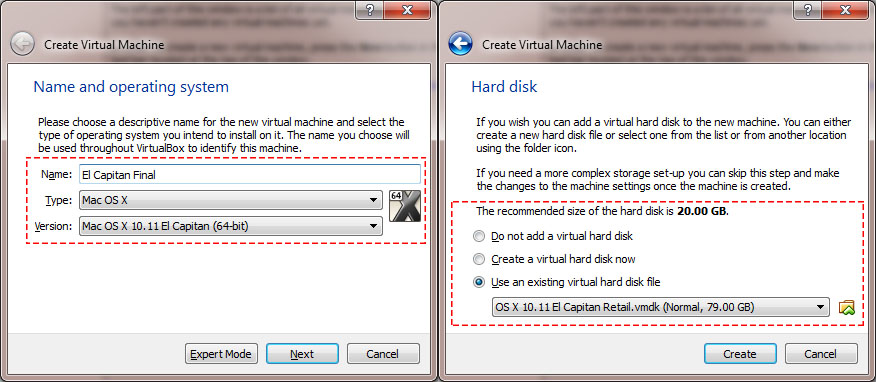
Failed to open a session for the virtual machine OS X 10.11 El Capitan. The virtual machine ‘OS X 10.11 El Capitan’ has terminated unexpectedly during startup with exit code 1 (0x1). More details may be available in ‘C: Users ADMIN VirtualBox VMs OS X 10.11 El Capitan Logs VBoxHardening.log’. Result Code: EFAIL (0x80004005). Open virtualbox and click ‘New’ to create a new virtual machine with the following details: Name: El Capitan Type: Mac OS X Version: Mac OS X 10.11 El Capitan (64 bit) Click next, select 4GB of RAM, and next again. Select the El Capitan image that you have downloaded and unzipped as the disk image, and create the machine. Right click on the image file you just download using WinRar to extract the Image File on any.
VirtualBox only officially supports OS X guests on an OS X host, but it is possible to create one on an OS X host and transfer it over to a Linux host. This tutorial will go over one possible way to accomplish this task.
What you will need


- An Apple computer running OS X 10.11
- A Linux computer to transfer the VM over to
- 20 GB free on the Apple Machine
- 40 GB free on the Linux Machine
Step One: VMWare
Install VMWare Fusion Pro on your OSX Host ( https://www.vmware.com/products/fusion/fusion-evaluation ). Open it up and select File -> New.
On the 'Select the Installation Method' menu, choose 'Install OSX from the recovery partition'. Follow the instructions and soon OSX will start installing in a VMWare VM. Go through the OSX installation process until the point where OSX asks you to setup the installation (IE: create users, etc). This could take up to two hours. Auto tune live rack. When its done, shutdown the VMWare VM.
In the VMWare 'Virtual Machine Library' menu, select the OSX VM you just created, and then select File -> Export To OVF.
This will create a folder with three files in it:
- .mf
- .ovf
- .vmdk
Step Two: Modify the OVF Files
El Capitan Amd Virtualbox
Next we need to take care of a few inconsistencies between VMWare's OVF format and VirtualBox's OVF format. Run the following commands on the .ovf file:
Since we have modified the OVF file, its SHA1 checksum will have changed. We need to update the .mf file to account for these changes. The .mf file should look something like this: Neopets stuck pets.
Run:
Take the resulting hash and replace the hash after SHA1(<VM_NAME>.ovf)= in <VM_NAME>.mf with this result.
Copy the OVF folder with all three files over to the Linux Machine.

Step Three: Import OVF into Linux host VirtualBox
Open up virtualbox on the Linux host, and import the OVF. You'll need to set the VM OS Type to 'Mac OS X' and the OS Version to 'Mac OS X 10.11 El-capitan (64-bit)'.
El Capitan Mac Os
Next, open up a terminal and run the following VBoxManage commands:
El Capitan Os X Download
Now you should be able to boot up the VM and have it run properly on the Linux host.
Comments are closed.